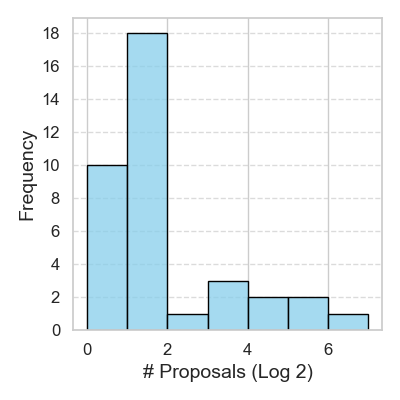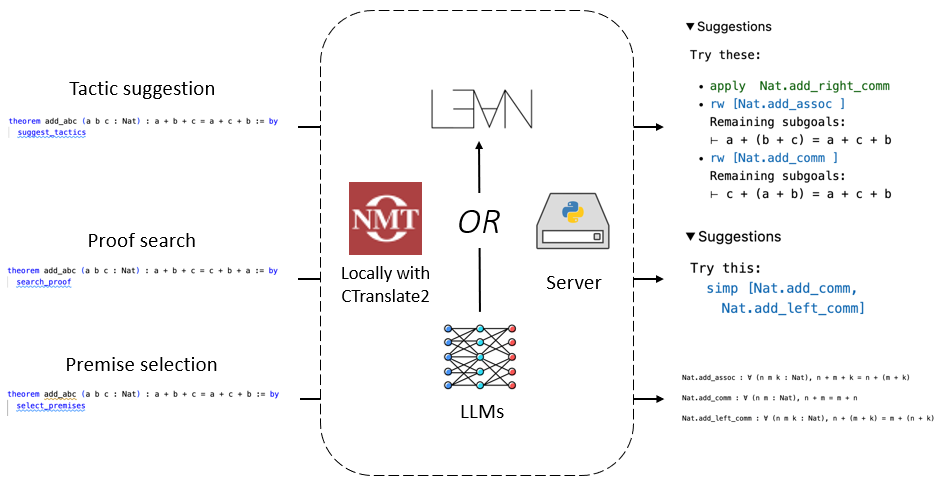Improving the Diproche CNL through Autoformalization via Large Language Models
2303.17513

0
0
💬
Abstract
The Diproche system is an automated proof checker for texts written in a controlled fragment of German, designed for didactical applications in classes introducing students to proofs for the first time. The first version of the system used a controlled natural language for which a Prolog formalization routine was written. In this paper, we explore the possibility of prompting large language models for autoformalization in the context of Diproche, with encouraging first results.
Get summaries of the top AI research delivered straight to your inbox:
Overview
- The Diproche system is an automated tool for checking proofs in a controlled version of the German language, designed for teaching students about proofs.
- The first version of Diproche used a specialized language that could be processed by a Prolog program.
- This paper explores using large language models to automatically translate natural language into the formal language required by Diproche.
Plain English Explanation
Diproche is a software system that can check whether a piece of text written in a simplified version of German correctly proves something. This can be useful for teaching students the basics of mathematical proofs, as the system can automatically verify whether the student's proof is valid.
The original Diproche system worked by having users write their proofs in a very specific, simplified language. This language could then be easily translated into a format that Diproche's underlying logic programming system could understand and check.
In this new research, the authors explore whether they can skip that step of having users write in the specialized language. Instead, they want to see if they can use powerful AI language models to automatically translate regular German text into the formal language required by Diproche. This could make the system much more user-friendly, as students would be able to write their proofs in plain language rather than having to learn a new, restricted way of writing.
The researchers report encouraging initial results with this new approach, suggesting it may be a promising avenue to make automated proof checking systems like Diproche more accessible.
Technical Explanation
The Diproche system is designed to provide automated feedback on mathematical proofs written in a controlled fragment of the German language. The first version of the system used a custom formal language, with a Prolog-based system to process and verify the proofs.
In this paper, the authors explore the use of large language models to enable "autoformalization" - the automatic translation of natural language proofs into the formal language required by Diproche. This could potentially make the system more user-friendly, as students would be able to write their proofs in plain German rather than having to learn a specialized proof language.
The researchers report positive initial results from experiments using language models to perform this autoformalization task. This suggests that leveraging large pre-trained models may be a promising approach to extend the capabilities of systems like Diproche, which aim to provide accessible tools for teaching mathematical reasoning.
Critical Analysis
The paper provides a compelling proof-of-concept for using language models to streamline the Diproche system. Automating the translation from natural language to formal logic could significantly lower the barrier to entry for students learning about proofs.
However, the paper does not delve into potential limitations or challenges with this approach. For example, it's unclear how well the language models would handle more complex or ambiguous proof statements. There may also be concerns around the reliability and trustworthiness of automated proof checking, compared to having a human expert verify the logic.
Additionally, the paper only reports on initial results, so more extensive testing and evaluation would be needed to fully assess the viability of this technique. Comparisons to alternative approaches for accessible proof assistance would also help situate the significance of this research.
Overall, the work presented is a promising first step, but further investigation is needed to understand the broader applicability and limitations of using large language models for autoformalization in educational proof systems like Diproche.
Conclusion
This paper explores an innovative approach to making automated proof checking more accessible by leveraging large language models. The Diproche system, designed for teaching mathematical proofs, originally required users to write in a specialized formal language.
The researchers' experiments with language model-based "autoformalization" suggest this may be a viable way to allow students to provide proofs in natural German text, which would then be automatically translated into the formal language required by Diproche. This could significantly lower the barrier to entry for beginners learning about proofs.
While further research is needed to fully evaluate the strengths and limitations of this technique, the initial results are encouraging. Automating the translation between natural and formal language has the potential to make proof assistance tools like Diproche much more user-friendly and accessible for educational purposes.
This summary was produced with help from an AI and may contain inaccuracies - check out the links to read the original source documents!
Related Papers
💬
Using Large Language Models for (De-)Formalization and Natural Argumentation Exercises for Beginner's Students
Merlin Carl (Europa-Universitat Flensburg)

0
0
We describe two systems currently being developed that use large language models for the automatized correction of (i) exercises in translating back and forth between natural language and the languages of propositional logic and first-order predicate logic and (ii) exercises in writing simple arguments in natural language in non-mathematical scenarios.
4/11/2024

Lemur: Integrating Large Language Models in Automated Program Verification
Haoze Wu, Clark Barrett, Nina Narodytska

0
0
The demonstrated code-understanding capability of LLMs raises the question of whether they can be used for automated program verification, a task that demands high-level abstract reasoning about program properties that is challenging for verification tools. We propose a general methodology to combine the power of LLMs and automated reasoners for automated program verification. We formally describe this methodology as a set of transition rules and prove its soundness. We instantiate the calculus as a sound automated verification procedure and demonstrate practical improvements on a set of synthetic and competition benchmarks.
4/26/2024

Towards Large Language Models as Copilots for Theorem Proving in Lean
Peiyang Song, Kaiyu Yang, Anima Anandkumar

0
0
Theorem proving is an important challenge for large language models (LLMs), as formal proofs can be checked rigorously by proof assistants such as Lean, leaving no room for hallucination. Existing LLM-based provers try to prove theorems in a fully autonomous mode without human intervention. In this mode, they struggle with novel and challenging theorems, for which human insights may be critical. In this paper, we explore LLMs as copilots that assist humans in proving theorems. We introduce Lean Copilot, a framework for running LLM inference in Lean. It enables programmers to build various LLM-based proof automation tools that integrate seamlessly into the workflow of Lean users. Using Lean Copilot, we build tools for suggesting proof steps (tactic suggestion), completing intermediate proof goals (proof search), and selecting relevant premises (premise selection) using LLMs. Users can use our pretrained models or bring their own ones that run either locally (with or without GPUs) or on the cloud. Experimental results demonstrate the effectiveness of our method in assisting humans and automating theorem proving process compared to existing rule-based proof automation in Lean. We open source all codes under a permissive MIT license to facilitate further research.
4/22/2024

New!Listen Again and Choose the Right Answer: A New Paradigm for Automatic Speech Recognition with Large Language Models
Yuchen Hu, Chen Chen, Chengwei Qin, Qiushi Zhu, Eng Siong Chng, Ruizhe Li

0
0
Recent advances in large language models (LLMs) have promoted generative error correction (GER) for automatic speech recognition (ASR), which aims to predict the ground-truth transcription from the decoded N-best hypotheses. Thanks to the strong language generation ability of LLMs and rich information in the N-best list, GER shows great effectiveness in enhancing ASR results. However, it still suffers from two limitations: 1) LLMs are unaware of the source speech during GER, which may lead to results that are grammatically correct but violate the source speech content, 2) N-best hypotheses usually only vary in a few tokens, making it redundant to send all of them for GER, which could confuse LLM about which tokens to focus on and thus lead to increased miscorrection. In this paper, we propose ClozeGER, a new paradigm for ASR generative error correction. First, we introduce a multimodal LLM (i.e., SpeechGPT) to receive source speech as extra input to improve the fidelity of correction output. Then, we reformat GER as a cloze test with logits calibration to remove the input information redundancy and simplify GER with clear instructions. Experiments show that ClozeGER achieves a new breakthrough over vanilla GER on 9 popular ASR datasets.
5/17/2024